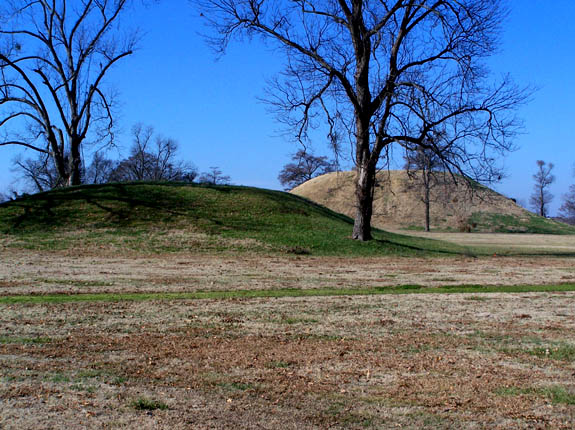|
Plum Bayou Mounds Archeological State Park
Plum Bayou Mounds Archeological State Park ( 3 LN 42), formerly known as "Toltec Mounds Archeological State Park", also known as Knapp Mounds, Toltec Mounds or Toltec Mounds site, is an archaeological site from the Late Woodland period in Arkansas that protects an 18-mound complex with the tallest surviving prehistoric mounds in Arkansas. The site is on the banks of Mound Lake, an oxbow lake of the Arkansas River. It was occupied by its original inhabitants from the 7th to the 11th century. The site is designated as a National Historic Landmark. Name The identification of the site with the Toltec of Mexico was a 19th-century misinterpretation. It was thought that the Toltec people lived in North America and built the mounds. Mary Knapp was the co-owner of the land from 1849 to 1905. She and her first husband purchased the land in 1849, and the land passed to her after his death. She and her second husband made subsequent land purchases near the site. Mary was interested in arc ... [...More Info...] [...Related Items...] OR: [Wikipedia] [Google] [Baidu] [Amazon] |
Lonoke County, Arkansas
Lonoke County is a county located in the Central Arkansas region of the U.S. state of Arkansas. As of the 2020 census, the population was 74,015, making it the 10th-most populous of Arkansas's 75 counties. The county seat is Lonoke and largest city is Cabot. Included in the Central Arkansas metropolitan area, with Little Rock as the principal city, it is an alcohol prohibition or dry county. Etymology Lonoke County was named for the "lone oak" located in the county at the time of its formation, by simply spelling it phonetically, at the suggestion of the chief engineer of the Cairo & Fulton Railroad. History Formed on April 16, 1873, from Pulaski and Prairie counties, Lonoke County's varied geography can be roughly broken into thirds horizontally. The top third has rolling hills at the edge of the Ozarks, including the Cabot area. The middle third, including the Lonoke area, contains portions of the Grand Prairie, a flat native grassland today known for rice farming, an ... [...More Info...] [...Related Items...] OR: [Wikipedia] [Google] [Baidu] [Amazon] |

